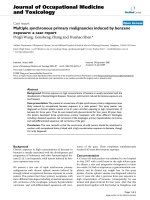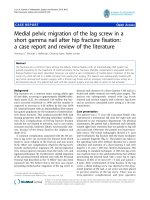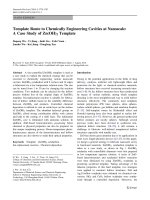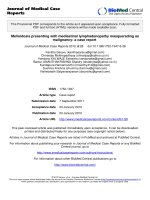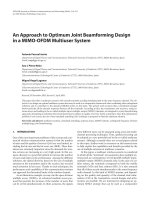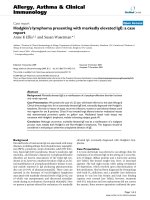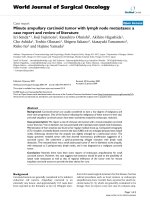báo cáo hóa học:" Medial pelvic migration of the lag screw in a short gamma nail after hip fracture fixation: a case report and review of the literature" potx
Bạn đang xem bản rút gọn của tài liệu. Xem và tải ngay bản đầy đủ của tài liệu tại đây (2.28 MB, 7 trang )
CAS E REP O R T Open Access
Medial pelvic migration of the lag screw in a
short gamma nail after hip fracture fixation:
a case report and review of the literature
Xinning Li
*
, Michael J Heffernan, Christina Kane, Walter Leclair
Abstract
Hip fractures are a common injury among the elderly. Internal fixation with an intramedullary (IM) system has
gained popularity for the treatment of intertrochanteric femur fractures. Multiple complications associated with IM
fracture fixation have been described, however, we report a rare complication of medial pelvic migration of the lag
screw of a short IM nail in a stable construct ten weeks post surgery. The patient was subsequently treated with
Lag Screw removal and revision surgery with a shorter Lag Screw and an accessory cannulated screw acting as a
de-rotational device. The patient did well with the revision surgery and was able to return to full activities.
Background
Hip fractures are a common injury among adults ages
65 and older, occurring in approximately 300,000 indivi-
duals yearly [1,2]. An estimated 1.66 million hip frac-
tures occurred worldwide in 1990 and the number is
expected to increase to 6.26 million by the year 2050
[3]. Internal fixation with an intramedullary (IM) system
has gained popularity for the treatment of inter trochan-
teric femur fractures. This construct provides both load
sharing properties while allowing immediate mobiliza-
tion [4,5]. Complications of IM hip fracture fixation
include but not limited to infection, mal or non uni on,
avascular necrosis, hardware failure, neurovascular inju-
ries, fracture of the femur distal to the implant, and
death [3-5].
A common complication associated with the IM sys-
tem is lag screw cut-out from the femoral head which
leads to varus collapse of the fracture and non-union
[6-8]. Other rare complications related to the lag screw
include medial pelvic migration [9], lateral migration
[10], extracorporeal extrusion from the body [11], and
sigmoid perforation [8]. Furthermore, medial migration
of the proximal femoral element seen with the Proxima l
Femoral Nail described as the “Z Effect” have also been
reported [12]. We believe this is the first case report
presenting medial pelvic migration of the lag screw or
femoral neck element of a short G amma 3 IM nail in a
locked and stable construct ten weeks post surgery. The
patient was subsequently treated with Lag Screw
removal and revision surgery with a shorter Lag Screw
and an accessory cannulated screw acting as a de-rota-
tional device.
Case presentation
The patient was a 77 year old Caucasian female who
experienced a mechanical fall onto her right side and
presented to our emergency department. On physical
examination, the patient had a shortened and externally
rotated right lower extremity that was painful to log-roll
and axial load. Otherwise the patient was neurovascu-
larly intact. The initial radiographs showed a 3- part
inter-trochanteric hip fracture with the lesser trochanter
as a separate fragment (Fig . 1). The patient was taken to
the operating room after medical clearance for a closed
reduction and insertion of a short Gamma 3 nail (125
degrees × 11 mm × 180 mm, Stryker, Kalamazoo, MI)
according to standard technique. A 100 mm lag screw
was inserted close to the subchondral bone but without
penetrating the femo ral head with a total Tip to Apex
Distance (TAD) of 13 mm (AP = 5 mm and Lateral =
8 mm). After confirmation of firm fixation of the lag
screw, a distal locking screw was inserted in the dyna-
mized position of IM nail. A set screw was then placed
to prevent rotation of the lag screw. There was no
intra-operative complications and post operative
* Correspondence:
University of Massachusetts Medical Center, Worcester, MA, USA
Li et al. Journal of Orthopaedic Surgery and Research 2010, 5:62
/>© 2010 Li et al; licensee BioMed Central Ltd. This is an Open Access article distributed under the terms of the Creative Co mmons
Attribu tion License (h ttp: //creativecommons.org/licenses/by/2.0), which permits unrestricted use, distribution, and reproduction in
any medium, provided the original work is properly cited.
anterior-posterior and lateral hip radiographs are seen in
Figs. 2 and 3. Post-operativel y, the patient was dis-
charged to rehab facility on day 3.
On the sixth week post operative visit, the patient had
no complaints and she has been weight bearing as toler-
ated. Anterior posterior right hip radiograph shows
some callus fo rmation and compression of the lag screw
without medial migration (Fig. 4). At the ten week fol-
low up visit, right hip radiographs revealed that the lag
screw along with the short IM nail construct had
migrated medially through her femoral head and
through the medial wall of her acetabulum (Fig. 5), how-
ever, the patient have been ambulating on her right
lower extremity and did not complaint of hip pain or
have any neurovascular deficits. Patient was subse-
quently admitted and underwent revision surgery with
remo val of the lag screw and placement of a shorter lag
screw after intra-operative stress confirmation of no visi-
ble fracture motion. An accessory cannulated screw was
then placed anterior and parallel to the Lag Screw to
provide de-rotational component (Fig. 6). The distal
locking screw of the IM nail was then removed to pro-
vide axial dynamization of the nail. The patient tolerated
the procedure well and continued to do well clinically at
the one year follow-up (Fig. 7) and currently back to full
activities with full weight bearing and cane assisted
ambulation.
Disscusion
Intertrochanteric hip fractures are very common among
the elderly [13,14]. There are many different fixation
devices developed for the management of these frac-
tures, with majority of them belonging to either the
intrameduallary or the sliding hip plate category. The
advantages of intrameduallary fixation system are
decreased intra-operative blood los s and operating room
time with immediate load-bearing. Better clinical out-
comes have also been reported when utilized in the
unstable fracture pattern when compared to the sliding
hip plates [4,15]. However, higher complication rates
associated with distal femur fracture and lag screw cut
out have also been reported with the IM system [4].
Several rare complications related to the lag screw in
an IM hip fixation system have been seen in the litera-
ture as case reports. Tauber et al. reported a case of sig-
moid perforation with free medial migration of the lag
screw in a Gamma nail. The complication presented 8
weeks post operative without any history of trauma. The
sigmoid perforation presented at 12 weeks as retroperi-
toneal abscess and sepsis. No intra-operative complica-
tions were reported from surgery and the authors could
not explain the cause of this complication [8]. Another
report in the literature described spontaneous extracor-
poreal extrusion of the Proximal Femoral Nail lag screw
from the body of a patient over one year from the date
Figure 1 Anterior-Posterior radiograph demonstrating a three part intertrochanteric hip fracture on the right side. Discontinuety of the
medial contex is seen with the less trochanter fracture fragment.
Li et al. Journal of Orthopaedic Surgery and Research 2010, 5:62
/>Page 2 of 7
of surgery. Given t hat the PFN system has no build in
mechanism to stop lateral migration of the lag screw,
the authors urged for a modi fication of the PFN system
[11,16]. Another case of lateral lag screw migration
without extrusion from the skin in the setting of a
minor trauma has also been reported [10].
Walking and normal weight bearing subjects the
implant and bone surface to combined axial and tor-
sional load that may play a role in lag screw migration.
Wer ner-Tutschku et al. described a complication of the
PFN when the superior anti-rotation screw penetration
into the femoral head or pelvis while the distal femoral
neck element (lag screw) migrating laterally. They
termed this the “Z-Effect” which was seen in 7.1% of
their cases (7/70) associated with the PNF with two
femoral neck elements. The authors attributed this com-
plication to bad pr imary repo sition i n varus which
causes collapse of the fracture and sliding of the inferior
neck screw laterally while the superior anti-rotational
screw migrated medially [6,12]. This “Z-Effect” or med-
ial migration of the femoral neck element (FNE) was
recently analyzed biomechanically. Several diff erent IM
hip fixation systems where tested and medial migration
of the femoral neck element was reproduced reliably in
each. The authors found that certain fracture patterns
(deficient lateral buttress or an unstable medial calcar)
that led to nail toggling within the femoral canal are
more likely to cause medial migration of the FNE in
implants with only one FNE. Preventing nail toggling
was able to prevent medial migration of the FNE. How-
ever, the exception to the rule was seen in the PFN with
two FNEs, as preventing nail toggling did not prevent
medial migration of the distal Lag Screw. Thus the
authors conclud ed a different mechanism other than
nail toggling may be responsible for the “ Z-Effect” seen
in the dual screw PFN systems [6]. Another biomechani-
cal study showed that specimens with the greatest
mechanical mismatch between femoral head and neck
exhibit lateral migration of the distal femoral neck ele-
ment of a dual screw IM system. Specifically, migration
is seen if the compressive strength of the femoral head
is much greater than the femoral neck, which simulates
fractures that h ave significant medial co rtex comminu-
tion that are prone to varus collapse [17].
In the presenting case, the patient had an unstable
intertrochanteric hip fracture with the discontinuity of
the medial cortex. A short Gamma 3 nail was placed
with the Lag Screw locked rotationally by the set screw.
The distal locking screw was then placed in the dyna-
mized position of the Gamma nail. We theorized that
over time with the compression of the fracture and
dynamization of the nail in the setting of an unstable
fracture pattern, there was togg ling of the nail within
the intrameduallary canal which led to the medial
migration of the Lag Screw with repeated axial loading.
This is the mechanism as proposed by Weil et al. in
their biomechanical study [6]. Further penetration of the
femoral head and eventual migration into the pelvis are
more likely to be seen with osteoporotic bone [17].
Intra-operatively during the revision surgery, the Lag
Screw was felt to be well fixed into the acetabulum even
in the setting of medial migration i nto the pelvis. The
patient was asymptomatic, which lead us to believe that
the Lag Screw may have migrated at the center of rota-
tion into the acetabulum thus with hip range of motion,
the patient did not experience significant pain. Furth er-
more, we stressed the fracture site intra-operatively after
Figure 2 Post-operative AP radiograph showing the reduction
of the three part hip fracture with placement of the short
Gamma 3 intrameduallary nail.
Li et al. Journal of Orthopaedic Surgery and Research 2010, 5:62
/>Page 3 of 7
Figure 3 Post-operative Lateral radiograph showing the reduction of the three part hip fracture with placement of the short Gamma
3 intrameduallary nail.
Figure 4 Anterior-Posterior radiographs at the six week post operative clinic visit shows compression of the Lag screw without medial
migration.
Li et al. Journal of Orthopaedic Surgery and Research 2010, 5:62
/>Page 4 of 7
removal of the Lag Screw and there was no fracture
motion, which indicated that the fracture was well
healed. Therefore, decision was made to replace the
longer Lag Screw with a shorter one. We also wanted a
de-rotational component to the IM construct to further
prevent spinning of the femoral head on the shorter Lag
Screw, therefore, a second cannulated screw was placed
into the femoral neck anterior and parallel to the
shorter Lag Screw. Furthermore, the shorter Lag Screw
was also locked rotationally by the set screw. The
patient did very well with the revision surgery and was
able to return to full activities.
Conclusion
Although the apparent mechanisms of the femoral neck
element (lag screw) medial pelvic migration are unde-
fined, incidents occur in part due to poor device place-
ment during surgery leading to varus collapse post
operatively, unstable fracture patterns especially with
comminution of the medial calcar or lateral cortex, and
Figure 5 Medial migration of the Lag Screw into the pelvis at the ten week post operative clinic visit.
Li et al. Journal of Orthopaedic Surgery and Research 2010, 5:62
/>Page 5 of 7
Figure 6 Intra-operative fluoroscopic image at the time of revision surgery. A shorter Lag Screw was placed and another accessory
cannulated screw placed anterior and in parallel to the Lag Screw.
Figure 7 Most recent AP hip radiograph at the one year post revision clinic visit shows good implant position and a well healed
intertrochanteric hip fracture.
Li et al. Journal of Orthopaedic Surgery and Research 2010, 5:62
/>Page 6 of 7
post-operative weight-bearing on osteoporotic bone have
been reported as contributing factors in literature. The
medial Lag Screw migration seen in our patien t is likely
a combination of the above mentioned factors. Even
with application of the set cap which stabilizes the c on-
struct in torsion, axial load may still cause toggling of
the nail within the femoral canal leading to medial
migration similar to what is seen in the “Z-Effect”.It’ s
also important to dem onstrate fracture healing by stres-
sing the hip intra-operatively. If there is no fracture
motion, then replacing the original Lag Screw with a
shorter Lag Screw and using a can nulated screw as a
de-rotational device can be used as a surgical manage-
ment option. Attention should be paid to the position of
the IM implant to minimize varus collapse in order to
decrease risk of medial migration of the Lag Screw.
Consent
Written informed consent was obtained from the patient for publication of
this case report and any accompanying images.
Competing interests
The authors declare that they have no competing interests.
Authors’ contributions
XL contributed to the data collection/interpretation, figures, and drafting/
revising of the entire manuscript. MH and CK contributed to the figure
collection and to the introduction and case presentation section. The
patient was evaluated and operated by WL. The final manuscript was seen
and approved by all authors before submission.
Received: 23 March 2010 Accepted: 27 August 2010
Published: 27 August 2010
References
1. Ehmke L, Fitzpatrick D, Krieg J, et al: Lag screws for hip fracture fixation:
Evaluation of migration resistance under simulated walking. Journal of
Orthopaedic Research 2005, 23:1329-35.
2. Richmond J, Aharonoff G, Zuckerman J, et al: Mortality risk after hip
fracture. Journal of Orthopedic Trauma 2003, 17:53-6.
3. Kenzora J, McCarthy R, Lowell J, et al: Hip fracture mortality: relation to
age, treatment, preoperative Illness, time of surgery, and complications.
Clinical Ortho Related Research 1984, 186:45-56.
4. Chinoy M, Parker M: Fixed nail plates versus sliding hip systems for the
treatment of trochanteric femoral fractures: a meta analysis of 14
studies. Injury 1999, 30:157-63.
5. Bridle S, Patel A, Bircher M, et al: Fixation of intertrochanteric fractures of
the femur. A randomised prospective comparison of the gamma nail
and the dynamic hip screw. Journal of Bone and Joint Surgery Br 1991,
73:330-34.
6. Weil Y, Gardner M, Mikhail G, et al: Medial migration of intramedullary hip
fixation devices: a biomechanical analysis. Arch Orthop Trauma Surg 2008,
128:227-234.
7. Stocker R, Maier R: Medial migration of lag screw in gamma nailing. Is it
the result of teechnical or implantation error? Unfallchirurg 2005,
108:79-80.
8. Tauber M, Resch H: Sigmoid perforation after medial migration of lag
screw in gamma nailing. Arch Orthop Trauma Surg 2006, 126:118-22.
9. Ramkumar U, Saffar T, Thinakarajan H, et al: Pelvic migration of lag screw
from a nailing device. Injury Extra 2006, 37:53-55.
10. Lasanianos N, Mouzopoulos G, Georgilas I: Hip screw lateral migration
with no cut-out or non-union implication: a case report. Cases Journal
2009, 2:6419.
11. Gun-ll I, Suk-Hyun L: Spontaneous extracorporeal extrusion of the lag
screw from a proximal femoral nail. Injury Extra 2006, 37:147-50.
12. Werner-Tutschku W, Lajtai G, Schmiedhuber G, et al: Intra- and
perioperative complications in the stabilization of per- and
subtrochanteric femoral fractures by means of PFN. Unfallchirurg 2002,
105:881-885.
13. Schipper I, Steyerberg E, Castelein R, et al
: Treatment of unstable
trochanteric fractures. Randomised comparison of the gamma nail and
the proximal femoral nail. Journal of Bone and Joint Surgery Am 2004,
86:86-94.
14. Kannusa P, Parkkaria J, Sievänena H, et al: Epidemiology of hip fractures.
Bone 1996, 18:57-63.
15. Park S, Yang K, Yoo J, et al: The treatment of reverse obliquity
intertrochanteric fractures with the intramedullary hip nail. The Journal of
Trauma injury, infection, and critical care 2006, 65:852-57.
16. Leung K, So W, Shen W, et al: Gamma nails and dynamic hip screws for
peritrochanteric fractures. A randomised prospective study in elderly
patients. Journal of Bone and Joint Surgery Am 1992, 74:345-51.
17. Strauss E, Kummer F, Koval K, et al: The “Z-Effect” phenomenon defined: A
laboratory study. Journal of Orthopaedic Research 2007, 25:1568-73.
doi:10.1186/1749-799X-5-62
Cite this article as: Li et al.: Medial pelvic migration of the lag screw in
a short gamma nail after hip fracture fixation: a case report and review
of the literature. Journal of Orthopaedic Surgery and Research 2010 5:62.
Submit your next manuscript to BioMed Central
and take full advantage of:
• Convenient online submission
• Thorough peer review
• No space constraints or color figure charges
• Immediate publication on acceptance
• Inclusion in PubMed, CAS, Scopus and Google Scholar
• Research which is freely available for redistribution
Submit your manuscript at
www.biomedcentral.com/submit
Li et al. Journal of Orthopaedic Surgery and Research 2010, 5:62
/>Page 7 of 7
